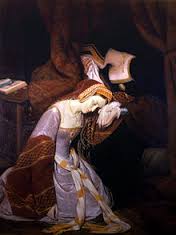 Queen Anne Boleyn’s execution had been scheduled for 18th May 1536, so carpenters worked through the night of the 17th building a new scaffold “before the House of Ordnance”1 and Anne Boleyn prepared herself for death by praying with her almoner.2
Queen Anne Boleyn’s execution had been scheduled for 18th May 1536, so carpenters worked through the night of the 17th building a new scaffold “before the House of Ordnance”1 and Anne Boleyn prepared herself for death by praying with her almoner.2
At dawn, Archbishop Thomas Cranmer arrived to hear her final confession and to celebrate the Mass with her. Anne asked for Sir William Kingston, Constable of the Tower of London and a man who was sending daily reports to Cromwell regarding Anne Boleyn’s words and behaviour, to be present while she took the sacrament. In his presence, she swore twice on the sacrament, before and after receiving the body of Christ, that she had never been unfaithful to the King. Kingston passed this information on to Cromwell, but it didn’t change anything, Anne had been found guilty of high treason by a jury of her peers, and now she had to pay the price.3
Anne then made arrangements for the customary distribution of alms, using the £20 given to her by the King for this purpose, before getting back to her prayers and waiting for Kingston to collect her for her execution.
By 9 o’clock, nothing had happened, and Anne had heard that her execution might be postponed until noon, so she sent for Kingston to find out what was going on. We can only imagine what she was going through. When he arrived, she told him what she’d heard, commenting that she was sorry if it was true because “I thought to be dead by this time, and past my pain”. By this time, Kingston had been notified that Anne’s execution was being postponed until the following day because Cromwell had asked him to clear the Tower of foreigners, but he didn’t tell Anne. He sought to comfort her, though, by explaining that her death would be quick and the blow from the sword “so subtle”. At this, Anne replied “I heard say the executioner was very good, and I have a little neck” and laughed as she put her hands around her throat”. A shocked Kingston reported back to Cromwell that “this lady has much joy and pleasure in death”.4
In those last awful hours, Anne was also able to joke with her ladies, saying that she’d go down in history as “la Royne Anne Sans Tete” or ‘Queen Anne Lackhead’.5
When noon had passed, and her execution still hadn’t taken place, Kingston finally informed Anne that her execution had been postponed until the following day. Eustace Chapuys, the imperial ambassador, heard that “Anne appeared very sorry, praying the Captain of the Tower that for the honor of God he would beg the King that, since she was in good state and disposed for death, she might be dispatched immediately”.6 Lancelot de Carles, secretary to the French ambassador, in his “Poeme sur la mort d’Anne Boleyn”, wrote:
“but when she perceived
That the appointed hour had passed
In her spirit she was dismayed,
And then she showed displeasure
That her hour had been delayed
Not that she desired death
But it seemed to her that she was prepared
To make a good death, and she believed that waiting
Did not weaken her and took it with grace.”
Despite her own feelings, Anne was able to comfort her ladies:
” […] seeing her ladies tormented
With great worry, [she] comforted them
Several times, saying to them that death
For Christians does not require comfort,
Since life eternal is in heaven,
Beyond the danger of the vicious world:
And for this reason they must not complain of her death
Because she hopes assuredly to reach
These happy and prosperous places,
Leaving here all infelicities.
Thus she taught her ladies well
That one must have disdain for this world
Where all is obsolete and transitory,
To hope in the eternal glory.”7
I can only hope that Anne’s faith did bring her comfort in those last hours which were so cruelly drawn out for her.
Notes and Sources
Image: Anne Boleyn à la Tour de Londres (1835), Edouard Cibot.
- Lisle Letters, Volume 3, 698, John Husee to Lord Lisle, 19 May 1536: “And Anne the late Queen suffered with sword this day, within the Tower, upon a new scaffold;”; Ives, Eric (2004) The Life and Death of Anne Boleyn, p. 423, note 1: “She was beheaded on a new scaffold ‘before the house of Ordnance’, i.e. on what is now the parade ground north of the White Tower”, citing “Antony Antony in Herbert, Henry VIII (1679), facing p.385.”
- Some say she prayed with her almoner John Skip, others say it was her confessor Father Thirwell.
- Letters and Papers, Foreign and Domestic, Henry VIII, Volume 10 – January-June 1536, 908, 910.
- Ibid, 910.
- Sergeant, Anne Boleyn: A Study, 269.
- LP X. 908.
- Lancelot de Carles’ “Poeme sur la mort d’Anne Boleyn”, in Georges Ascoli’s 1927 La Grande-Bretagne devant l’opinion française depuis la guerre de cent ans jusqu’a la fin du XVIe siecle, lines 1156 – 1164, 1167-1180 translated from French in “Anne Boleyn, Lancelot de Carle, and the Uses of Documentary Evidence” by Susan Walters Schmid, Arizona State University, December 2009.